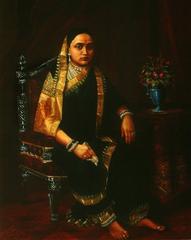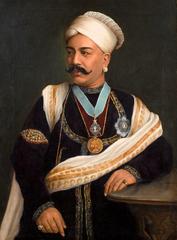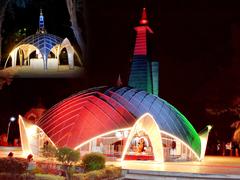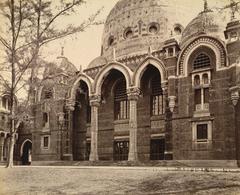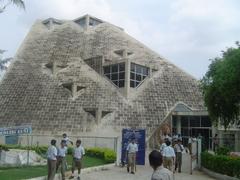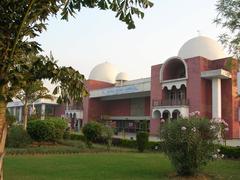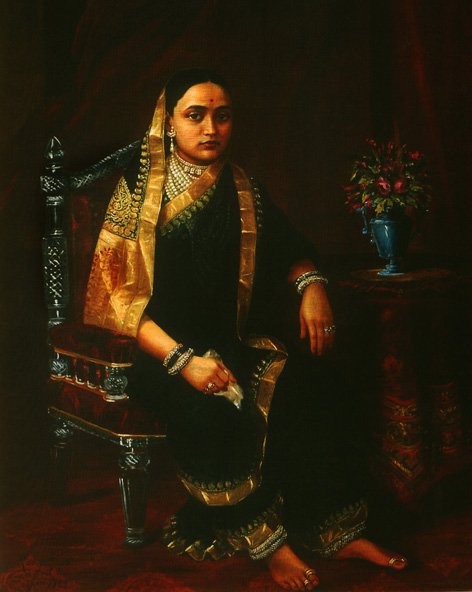
Guide to Visiting Laxmi Vilas Palace in Vadodara
Date: 18/07/2024
Introduction
Laxmi Vilas Palace, located in Vadodara, Gujarat, is a remarkable blend of history, architectural grandeur, and cultural heritage. Commissioned by Maharaja Sayajirao Gaekwad III in 1878, the palace was completed in 1890 and stands as a testament to the visionary ruler’s progressive reforms and patronage of the arts. The palace embodies the Indo-Saracenic architectural style, a harmonious fusion of Islamic, Mughal, and European influences that flourished in 19th-century India. Designed by Major Charles Mant, a British architect, Laxmi Vilas Palace is spread over a sprawling 500-acre complex, making it one of the largest private residences in the world (source). The palace boasts an array of notable features, from the grand Darbar Hall to the intricately carved Navlakhi Stepwell, each element narrating a unique story of grandeur and innovation (source). Visitors are treated to a visual feast of red sandstone from Agra, intricate blue tiles from Burma, and marble from various parts of India, making it an architectural marvel (source). Today, the palace continues to be a living legacy of the Gaekwad dynasty, partially open to the public while still serving as the residence of the royal family (source).
Table of Contents
- [Discover the History and Architectural Splendor of Laxmi Vilas Palace](#discover-the-history-and-architectural-splendor-of-laxmi-vilas-palacediscover-the-history-and-architectural-splendor-of-laxmi-vilas-palace)
- [A Legacy in Stone and Steel](#a-legacy-in-stone-and-steela-legacy-in-stone-and-steel)
- [Indo-Saracenic Splendor](#indo-saracenic-splendorindo-saracenic-splendor)
- [A Symphony of Design and Innovation](#a-symphony-of-design-and-innovationa-symphony-of-design-and-innovation)
- [Notable Features and their Significance](#notable-features-and-their-significancenotable-features-and-their-significance)
- [Visitor Information - Tickets and Visiting Hours](#visitor-information---tickets-and-visiting-hoursvisitor-information-tickets-and-visiting-hours)
- [Travel Tips](#travel-tipstravel-tips)
- [Nearby Attractions](#nearby-attractionsnearby-attractions)
- [Accessibility](#accessibilityaccessibility)
- [A Palace of Firsts in India](#a-palace-of-firsts-in-indiaa-palace-of-firsts-in-india)
- [A Living Legacy](#a-living-legacya-living-legacy)
- [Frequently Asked Questions](#frequently-asked-questionsfrequently-asked-questions)
- [Exploring the Cultural Richness of Laxmi Vilas Palace](#exploring-the-cultural-richness-of-laxmi-vilas-palaceexploring-the-cultural-richness-of-laxmi-vilas-palace)
- [Cultural Importance and Attractions](#cultural-importance-and-attractionscultural-importance-and-attractions)
- [Patronage of the Arts](#patronage-of-the-artspatronage-of-the-arts)
- [A Window into History](#a-window-into-historya-window-into-history)
- [Architectural Fusion](#architectural-fusionarchitectural-fusion)
- [Gardens and Grounds](#gardens-and-groundsgardens-and-grounds)
- [Cultural Events](#cultural-eventscultural-events)
- [Symbol of Vadodara](#symbol-of-vadodarasymbol-of-vadodara)
- [Visitor Information](#visitor-informationvisitor-information)
- [Visiting Hours and Tickets](#visiting-hours-and-ticketsvisiting-hours-and-tickets)
- [Travel Tips and Accessibility](#travel-tips-and-accessibilitytravel-tips-and-accessibility)
- [Nearby Attractions](#nearby-attractionsnearby-attractions)
- [FAQ](#faqfaq)
- [Cultural Importance and Attractions](#cultural-importance-and-attractionscultural-importance-and-attractions)
- [Visiting Laxmi Vilas Palace](#visiting-laxmi-vilas-palacevisiting-laxmi-vilas-palace)
- [Visitor Information and Tips](#visitor-information-and-tipsvisitor-information-and-tips)
- [Opening Hours and Ticket Prices](#opening-hours-and-ticket-pricesopening-hours-and-ticket-prices)
- [Getting There](#getting-theregetting-there)
- [Best Time to Visit](#best-time-to-visitbest-time-to-visit)
- [Exploring the Palace](#exploring-the-palaceexploring-the-palace)
- [Guided Tours](#guided-toursguided-tours)
- [Audio Guides](#audio-guidesaudio-guides)
- [Must-See Areas](#must-see-areasmust-see-areas)
- [Photography Tips](#photography-tipsphotography-tips)
- [Where to Stay](#where-to-staywhere-to-stay)
- [Where to Eat](#where-to-eatwhere-to-eat)
- [Tips for a Memorable Visit](#tips-for-a-memorable-visittips-for-a-memorable-visit)
- [History and Cultural Significance](#history-and-cultural-significancehistory-and-cultural-significance)
- [Special Events](#special-eventsspecial-events)
- [FAQ](#faqfaq-1)
- [Visitor Information and Tips](#visitor-information-and-tipsvisitor-information-and-tips)
- [Conclusion](#conclusionconclusion)
- [References](#referencesreferences)
Discover the History and Architectural Splendor of Laxmi Vilas Palace
The Laxmi Vilas Palace in Vadodara, Gujarat, India, is not just a palace; it’s a testament to a glorious era and an architectural marvel. Its history and design are deeply intertwined, reflecting the grandeur and progressive vision of the Gaekwad dynasty.
A Legacy in Stone and Steel
Commissioned by Maharaja Sayajirao Gaekwad III in 1878, the palace’s construction took 12 years and was completed in 1890. The Maharaja, a visionary ruler known for his progressive reforms and patronage of the arts, envisioned a palace that would showcase the prowess of Indian craftsmanship while embracing modern architectural trends.
Indo-Saracenic Splendor
The palace is a splendid example of Indo-Saracenic architecture, a style that flourished in 19th-century India. This architectural vocabulary blends elements of Islamic, Mughal, and European architectural styles, resulting in a unique and visually captivating aesthetic.
- Islamic influences are evident in the intricate jalis (latticed screens), delicate arches, and ornate domes that adorn the palace.
- Mughal elements are reflected in the sprawling gardens, water features, and the use of marble and sandstone.
- European architectural styles, particularly the Victorian and Gothic Revival, are visible in the palace’s overall layout, the use of stained glass windows, and the incorporation of modern amenities like elevators.
A Symphony of Design and Innovation
Designed by Major Charles Mant, a renowned British architect, the palace sprawls across a sprawling 500-acre complex. The structure incorporates a range of materials, including:
- Red sandstone brought from Agra
- Intricate blue tiles from Burma
- Marble sourced from different parts of India
This fusion of materials, coupled with the intricate carvings and decorative elements, creates a visual feast for visitors.
Notable Features and their Significance
The Laxmi Vilas Palace is a treasure trove of architectural marvels, each element telling a story of its own:
- The Darbar Hall: This grand hall, with its ornate arches, intricate carvings, and a ceiling adorned with Venetian mosaic tiles, served as the venue for royal gatherings and durbars (court assemblies). The hall’s acoustics are exceptional, designed to amplify music and speeches.
- The Langoor Room: This unique room gets its name from the intricately carved sandstone friezes depicting playful monkeys (langoors). It served as a waiting room for guests during royal events.
- The Coronation Room: This historically significant room witnessed the coronation ceremonies of the Gaekwad rulers. It houses portraits of the Gaekwad dynasty and showcases their rich history.
- The Navlakhi Stepwell: Located within the palace complex, this intricately carved stepwell is an architectural marvel. Its name, Navlakhi, refers to the nine lakh (900,000) rupees it cost to build in the 19th century.
- The Gardens: The palace is surrounded by sprawling Mughal gardens, designed for both aesthetic pleasure and functionality. These gardens, with their fountains, pavilions, and manicured lawns, provided a serene escape for the royal family.
Visitor Information - Tickets and Visiting Hours
For those planning to explore this magnificent palace, here are some essential details:
- Visiting Hours: The palace is open to visitors from 10:00 AM to 5:00 PM daily, except on public holidays.
- Ticket Prices: The entry fee is INR 200 for Indian citizens and INR 400 for foreign tourists. Children below the age of 12 can enter for free.
- Guided Tours: Guided tours are available at an additional cost, providing a more in-depth understanding of the palace’s history and architecture.
Travel Tips
- Best Time to Visit: The ideal time to visit Vadodara is between October and March, when the weather is pleasant.
- Photography: Photography is allowed in the palace gardens but prohibited inside the palace. Make sure to check the guidelines before starting your tour.
- Dress Code: There is no strict dress code, but visitors are advised to dress modestly out of respect for the historical site.
Nearby Attractions
While in Vadodara, consider visiting these nearby attractions:
- Sayaji Baug: A sprawling garden featuring a zoo, planetarium, and museum, located just a short drive from the palace.
- Baroda Museum and Picture Gallery: Housing an extensive collection of art and artifacts, this museum offers a deeper insight into the region’s history and culture.
- Kirti Mandir: A beautiful temple built in memory of the Gaekwad rulers, showcasing intricate carvings and architectural elegance.
Accessibility
- Wheelchair Accessibility: The palace grounds are wheelchair accessible, with ramps and elevators available for ease of movement.
- Parking: Ample parking space is available for visitors, including designated spots for differently-abled individuals.
- Public Transport: The palace is well-connected by public transport, with buses, auto-rickshaws, and taxis readily available.
A Palace of Firsts in India
The Laxmi Vilas Palace was ahead of its time in terms of incorporating modern amenities. It was:
- One of the first buildings in India to have electricity. The palace had its own power plant, a testament to Maharaja Sayajirao Gaekwad III’s progressive outlook and his keenness to embrace modern technology.
- Equipped with elevators, a rare feature in Indian palaces at that time. This reflected the Maharaja’s consideration for the comfort of his guests and family members.
A Living Legacy
Today, the Laxmi Vilas Palace is not just a historical monument but a living legacy of the Gaekwad dynasty. Still home to the royal family, a portion of the palace is open to the public, offering a glimpse into the opulent lifestyle of the erstwhile rulers. The palace also houses a museum showcasing a remarkable collection of artifacts, weaponry, and artwork, providing further insights into the history and culture of the Gaekwad era.
Frequently Asked Questions
- What are the visiting hours for Laxmi Vilas Palace? The palace is open from 10:00 AM to 5:00 PM daily, except on public holidays.
- How much are the tickets for Laxmi Vilas Palace? The entry fee is INR 200 for Indian citizens and INR 400 for foreign tourists. Children below 12 years can enter for free.
- Is photography allowed inside Laxmi Vilas Palace? Photography is allowed in the palace gardens but prohibited inside the palace.
- Is the palace wheelchair accessible? Yes, the palace grounds are wheelchair accessible, with ramps and elevators available.
Exploring the Cultural Richness of Laxmi Vilas Palace
Cultural Importance and Attractions
Patronage of the Arts
The Gaekwads were renowned patrons of the arts, and this is evident in the palace’s collection. The palace houses a remarkable collection of sculptures and paintings by Raja Ravi Varma, one of India’s most celebrated artists. The intricate carvings, murals, and frescoes throughout the palace showcase the artistic skills prevalent during that era.
A Window into History
The palace museum offers a captivating journey through the history of the Gaekwads. Visitors can explore exhibits featuring royal artifacts, vintage cars, personal belongings of the royal family, and historical documents. These artifacts provide a tangible link to the past and offer insights into the lifestyle and grandeur of the Gaekwad rulers.
Architectural Fusion
The palace’s architecture is a testament to the Gaekwads’ global outlook. The Indo-Saracenic style seamlessly blends elements of Indian, Mughal, Maratha, and European architectural styles. This fusion is visible in the intricate jalis (stone lattices), ornate arches, sprawling courtyards, and the grand Darbar Hall with its Venetian mosaic floor and Belgian stained-glass windows.
Gardens and Grounds
The palace sits amidst sprawling landscaped gardens that add to its charm. These gardens, inspired by Mughal and European styles, provide a serene escape from the city’s bustle. Visitors can stroll through the manicured lawns, admire the fountains, and enjoy the tranquility of the surroundings.
Cultural Events
The Laxmi Vilas Palace continues to be a vibrant cultural hub. The palace grounds host various cultural events and performances throughout the year, showcasing traditional Indian dance, music, and art forms. These events offer visitors a glimpse into the rich cultural tapestry of Gujarat.
Symbol of Vadodara
The Laxmi Vilas Palace is the most prominent landmark in Vadodara and a source of immense pride for its residents. It represents the city’s royal legacy and its contribution to India’s cultural heritage. The palace attracts visitors from all over the world, contributing significantly to the city’s tourism industry.
Visitor Information
Visiting Hours and Tickets
Laxmi Vilas Palace is open to visitors from 9:30 AM to 5:00 PM on all days except Mondays and public holidays. Tickets can be purchased at the palace entrance or online through the official website. The ticket prices are INR 200 for adults and INR 150 for children and students.
Travel Tips and Accessibility
The palace is easily accessible by road and is well-connected to major parts of Vadodara. Visitors are advised to wear comfortable footwear as the tour involves a significant amount of walking. The palace premises are wheelchair accessible, ensuring a comfortable visit for all.
Nearby Attractions
While in Vadodara, visitors can also explore nearby attractions such as Sayaji Baug, Baroda Museum and Picture Gallery, and the Maharaja Fateh Singh Museum. These sites offer additional insights into the city’s rich history and culture.
FAQ
Q: What are the visiting hours for Laxmi Vilas Palace?
A: The palace is open from 9:30 AM to 5:00 PM, except on Mondays and public holidays.
Q: How much are tickets for Laxmi Vilas Palace?
A: Tickets cost INR 200 for adults and INR 150 for children and students.
Visiting Laxmi Vilas Palace
Visitor Information and Tips
Opening Hours and Ticket Prices
The Laxmi Vilas Palace welcomes visitors:
- Tuesday to Sunday: 9:30 AM to 5:00 PM
- Monday: Closed
Ticket Prices:
- Palace: INR 225 for Indians, INR 500 for foreigners
- Maharaja Fateh Singh Museum: INR 80 for Indians, INR 200 for foreigners
- Audio Guide: Available for an additional fee.
Note: Ticket prices are subject to change. It’s always a good idea to check the official Laxmi Vilas Palace website or contact the palace authorities for the most up-to-date information.
Getting There
- By Air: The nearest airport is Vadodara Airport (BDQ), about 6 kilometers from the city center. From the airport, taxis and auto-rickshaws are readily available.
- By Train: Vadodara is well-connected by rail to major cities in India. Vadodara Junction Railway Station (BRC) is about 4 kilometers from the palace.
- By Road: Vadodara is on National Highway 48, making it easily accessible from nearby cities like Ahmedabad and Surat. State-run and private buses operate frequent services to Vadodara.
- Local Transport: Within Vadodara, auto-rickshaws, taxis, and local buses are convenient ways to reach the palace.
Best Time to Visit
The best time to visit Laxmi Vilas Palace is during the winter months (October to March) when the weather is pleasant and ideal for exploring the palace grounds. Summers (April to June) can be extremely hot in Vadodara, so it’s best to avoid visiting during these months. The monsoon season (July to September) brings heavy rainfall, which can make it difficult to enjoy the outdoor areas of the palace.
Exploring the Palace
Guided Tours
Guided tours are available in English and Hindi and offer valuable insights into the history, architecture, and art of the palace.
Audio Guides
For a more personalized experience, audio guides are available in multiple languages, allowing you to explore the palace at your own pace.
Must-See Areas
- Durbar Hall: The grandest hall in the palace, known for its intricate carvings, stained-glass windows, and chandeliers.
- Coronation Room: The historic room where the Gaekwads of Baroda were crowned.
- Museum: Houses a remarkable collection of artifacts, including weapons, sculptures, paintings, and royal memorabilia.
- Gardens: The palace is surrounded by sprawling gardens adorned with fountains, sculptures, and manicured lawns.
Photography Tips
Photography is permitted in most areas of the palace, except for certain restricted sections. However, using flash photography is generally prohibited inside the palace to protect the delicate artwork and artifacts.
Tips for capturing stunning shots:
- Durbar Hall: Capture the grandeur of the hall by shooting from different angles, highlighting the intricate details and the play of light through the stained-glass windows.
- Coronation Room: Focus on the ornate throne and the historical significance of the room.
- Gardens: Take advantage of the natural light and capture the beauty of the fountains, sculptures, and greenery.
Where to Stay
Vadodara offers a range of accommodation options to suit different budgets, from luxury hotels to budget-friendly guesthouses. Some popular choices near the palace include:
- The Taj Gateway Hotel: A luxurious hotel located within the palace grounds.
- WelcomHotel by ITC Hotels: A comfortable and stylish hotel within a short distance of the palace.
- Hotel Surya Palace: A budget-friendly option offering decent amenities.
Where to Eat
Vadodara is known for its delicious Gujarati cuisine. Here are some recommended places to savor local flavors:
- Mandap: A popular restaurant serving authentic Gujarati thalis.
- Sasumaa Gujarati Thali: Another great option for a traditional Gujarati meal.
- Jagdish Farsan: A local favorite for snacks and street food.
Tips for a Memorable Visit
- Dress Code: While there is no strict dress code, it’s respectful to dress modestly when visiting the palace.
- Footwear: Be prepared to remove your shoes before entering certain areas of the palace.
- Hydration: Carry a water bottle to stay hydrated, especially during warmer months.
- Souvenirs: The palace shops offer a variety of souvenirs, including handicrafts, textiles, and miniature paintings.
- Respectful Behavior: Remember to be respectful of the palace’s historical and cultural significance. Avoid touching or climbing on artifacts andmaintain a reasonable volume when speaking.
History and Cultural Significance
Laxmi Vilas Palace, built by Maharaja Sayajirao Gaekwad III in 1890, is four times the size of Buckingham Palace. It remains the residence of the royal family of Vadodara and is a fine example of Indo-Saracenic architecture. The palace grounds also include the Maharaja Fateh Singh Museum, which showcases various artworks and artifacts, reflecting the rich cultural heritage of the Gaekwads.
Special Events
Throughout the year, Laxmi Vilas Palace hosts various cultural events, exhibitions, and performances. These events offer a unique opportunity to experience the vibrant culture and traditions of Vadodara.
FAQ
Q: What are the opening hours of Laxmi Vilas Palace?
A: The palace is open from Tuesday to Sunday, 9:30 AM to 5:00 PM, and closed on Mondays.
Q: How much are the tickets for Laxmi Vilas Palace?
A: Tickets are priced at INR 225 for Indians and INR 500 for foreigners for the palace, and INR 80 for Indians and INR 200 for foreigners for the Maharaja Fateh Singh Museum.
Q: Are guided tours available at Laxmi Vilas Palace?
A: Yes, guided tours in English and Hindi are available.
Q: When is the best time to visit Laxmi Vilas Palace?
A: The best time to visit is during the winter months (October to March).
Q: Is photography allowed inside Laxmi Vilas Palace?
A: Photography is allowed in most areas except restricted sections. Flash photography is generally prohibited.
By following these tips, you can ensure a memorable and enriching experience at the magnificent Laxmi Vilas Palace in Vadodara.
Call to Action
For more updates and information, consider downloading the Audiala mobile app, checking out our other related posts, or following us on social media.
Conclusion
Laxmi Vilas Palace is not merely an architectural wonder but a living repository of Vadodara’s rich cultural heritage and the grandeur of the Gaekwad dynasty. From its Indo-Saracenic architectural splendor to its role as a vibrant cultural hub, the palace offers a deep dive into the region’s history and artistic legacy. Visitors are not only mesmerized by its visual grandeur but also gain insights into the progressive vision of Maharaja Sayajirao Gaekwad III, who was ahead of his time in incorporating modern amenities like electricity and elevators (source). The palace’s extensive collections of artwork, artifacts, and royal memorabilia provide a tangible link to the past, making it a must-visit destination for history enthusiasts and cultural aficionados alike. Whether strolling through the Mughal-inspired gardens, exploring the grand Darbar Hall, or attending one of the many cultural events hosted on its grounds, a visit to Laxmi Vilas Palace is an unforgettable journey through time. It continues to be a symbol of Vadodara’s royal legacy and a significant contributor to the city’s tourism, attracting visitors from around the globe (source).
References
- Discover the History and Architectural Splendor of Laxmi Vilas Palace, 2024, Laxmi Vilas Palace https://www.laxmivilaspalace.com
